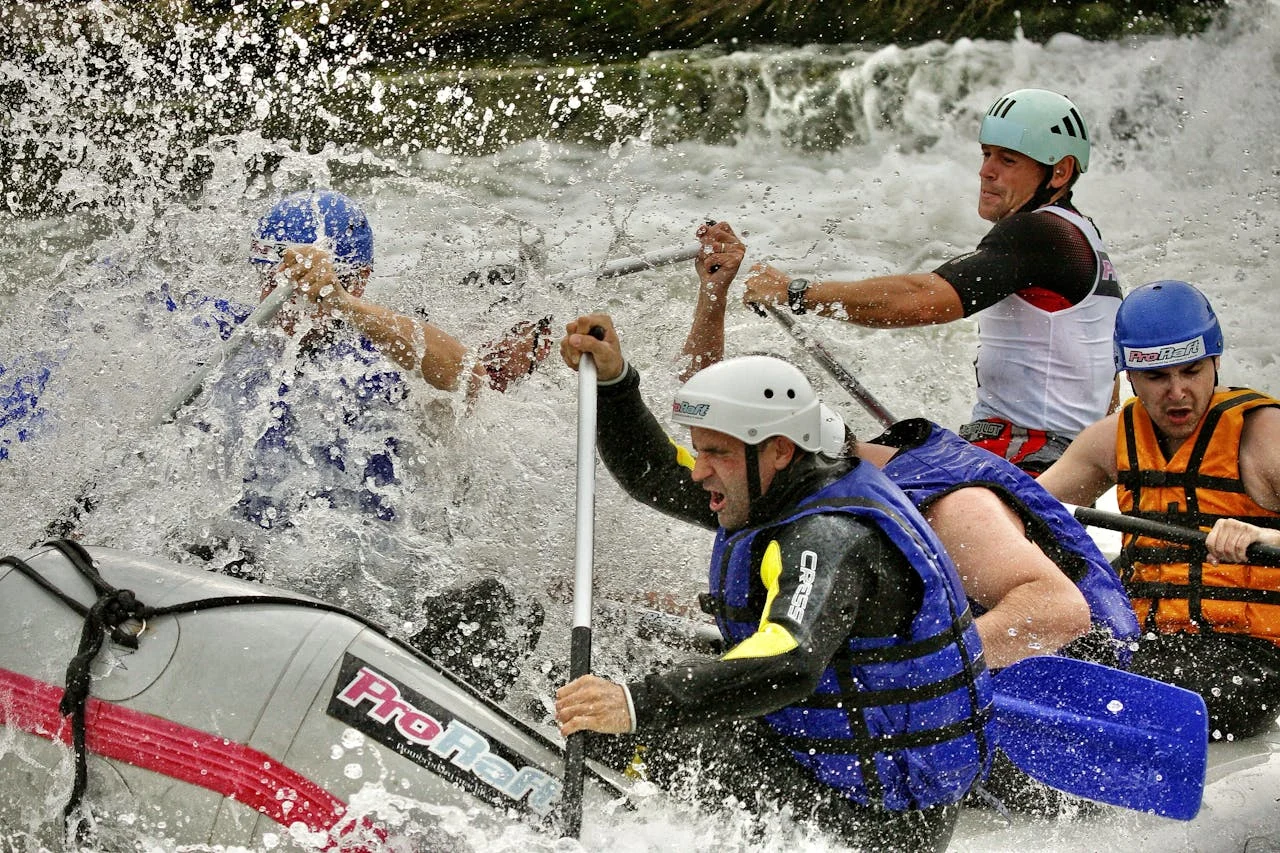Your Ultimate Guide to Whitewater Rafting in Jackson, WY
Planning your next whitewater rafting adventure doesn't have to be overwhelming, especially when you're exploring one of America's most spectacular rafting destinations. Jackson, Wyoming, positioned at the base of the Teton Range with the Snake River flowing through its heart, offers whitewater experiences that range from peaceful scenic floats perfect for families to adrenaline-pumping Class III rapids that challenge experienced rafters.
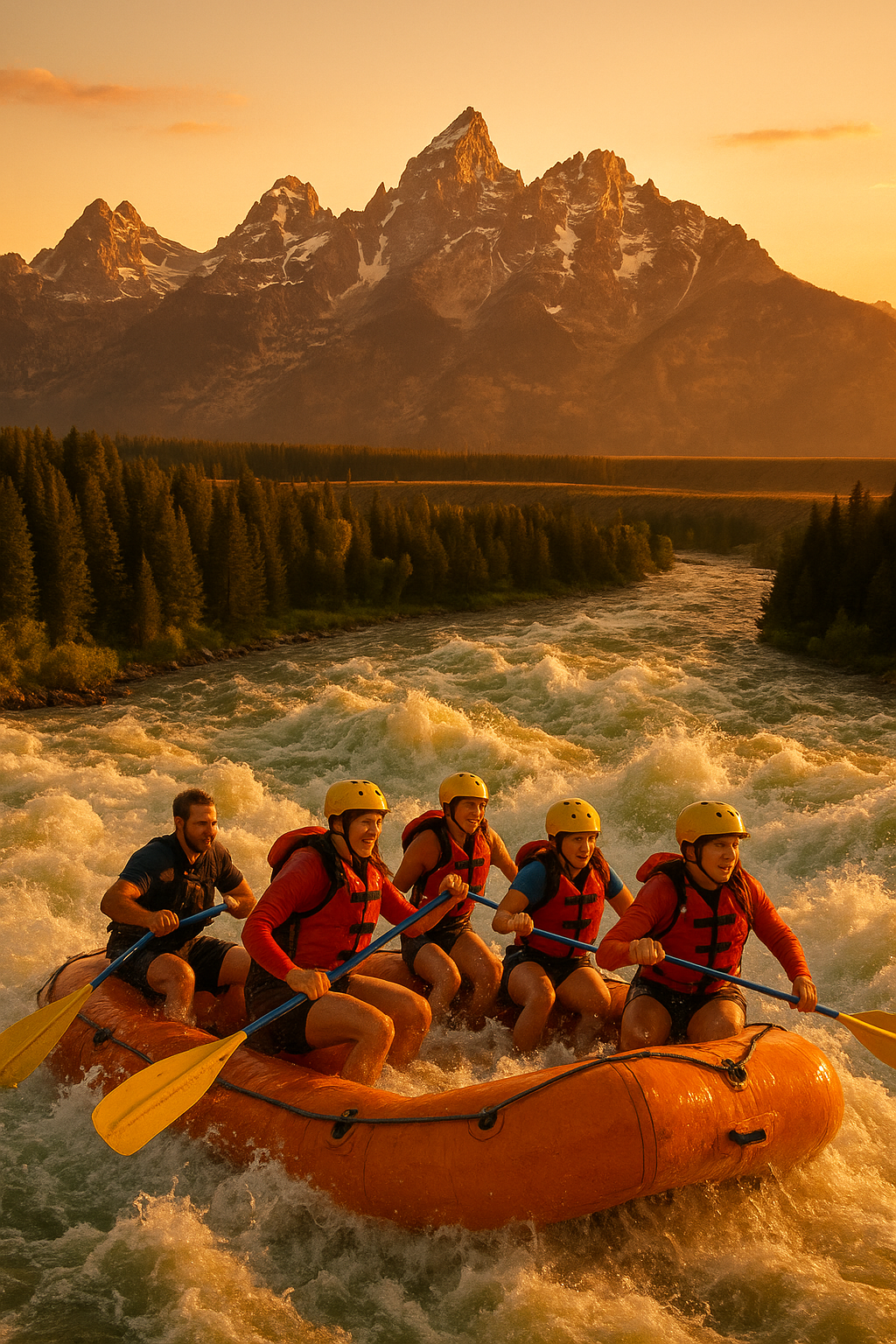
Here's what makes Jackson extraordinary for whitewater rafting: you're positioned in a destination where the Snake River provides over 50 miles of raftable water through some of North America's most spectacular scenery, with sections ranging from gentle floats through wildlife habitat to technical rapids that have trained Olympic kayakers. Whether you're looking for a peaceful family float to spot moose and eagles, an intermediate whitewater experience combining scenery with excitement, or challenging rapids that test your mettle, this guide will help you choose the perfect Snake River adventure.
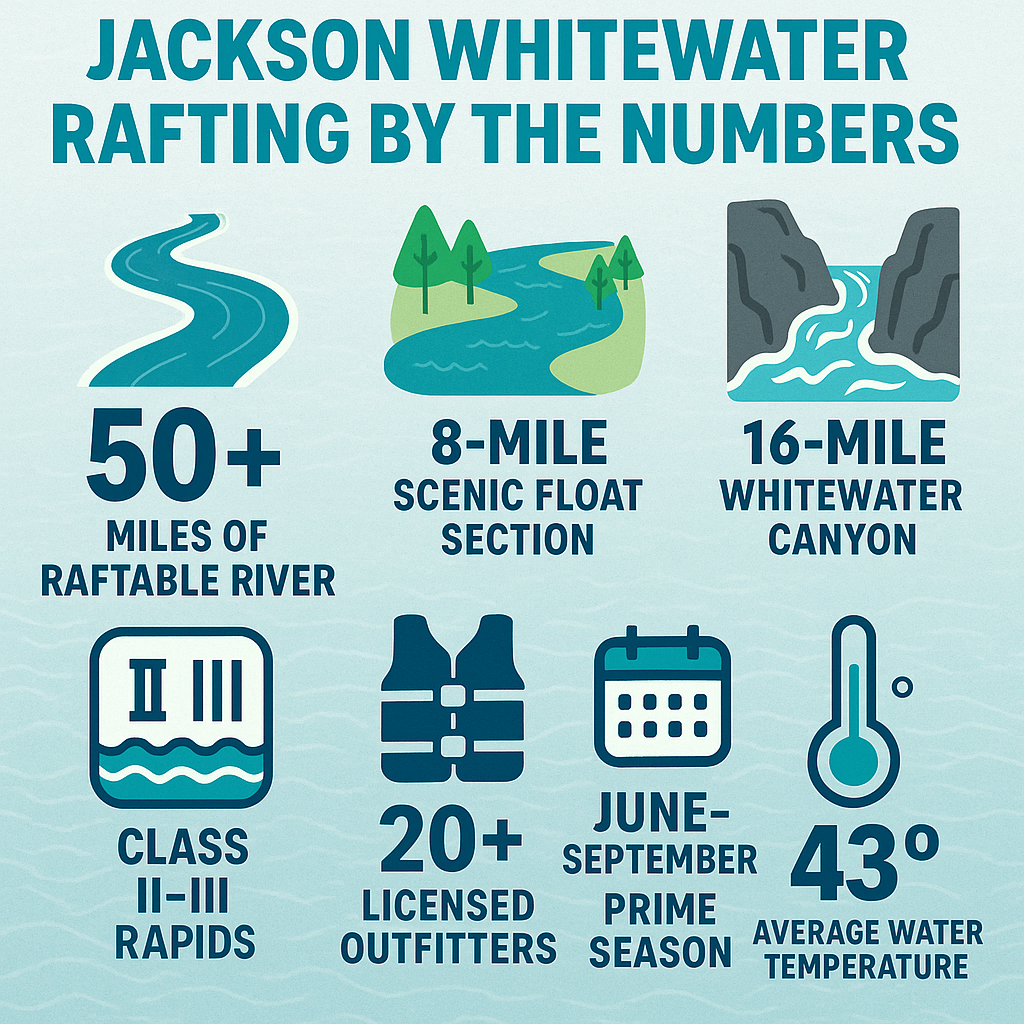
With access to the calm-water scenic float from Jackson Lake Dam through the Tetons, the exciting whitewater of the Snake River Canyon with rapids like Lunch Counter and Rope, established outfitters providing professional guides and equipment, and a rafting season running from late May through September, Jackson serves as one of the West's premier rafting destinations. The region's cold, clear water flowing from Yellowstone and the Tetons, combined with professional safety standards and spectacular wilderness scenery, creates conditions ideal for both first-time rafters and experienced whitewater enthusiasts.
GETTING STARTED: Your First Snake River Adventure
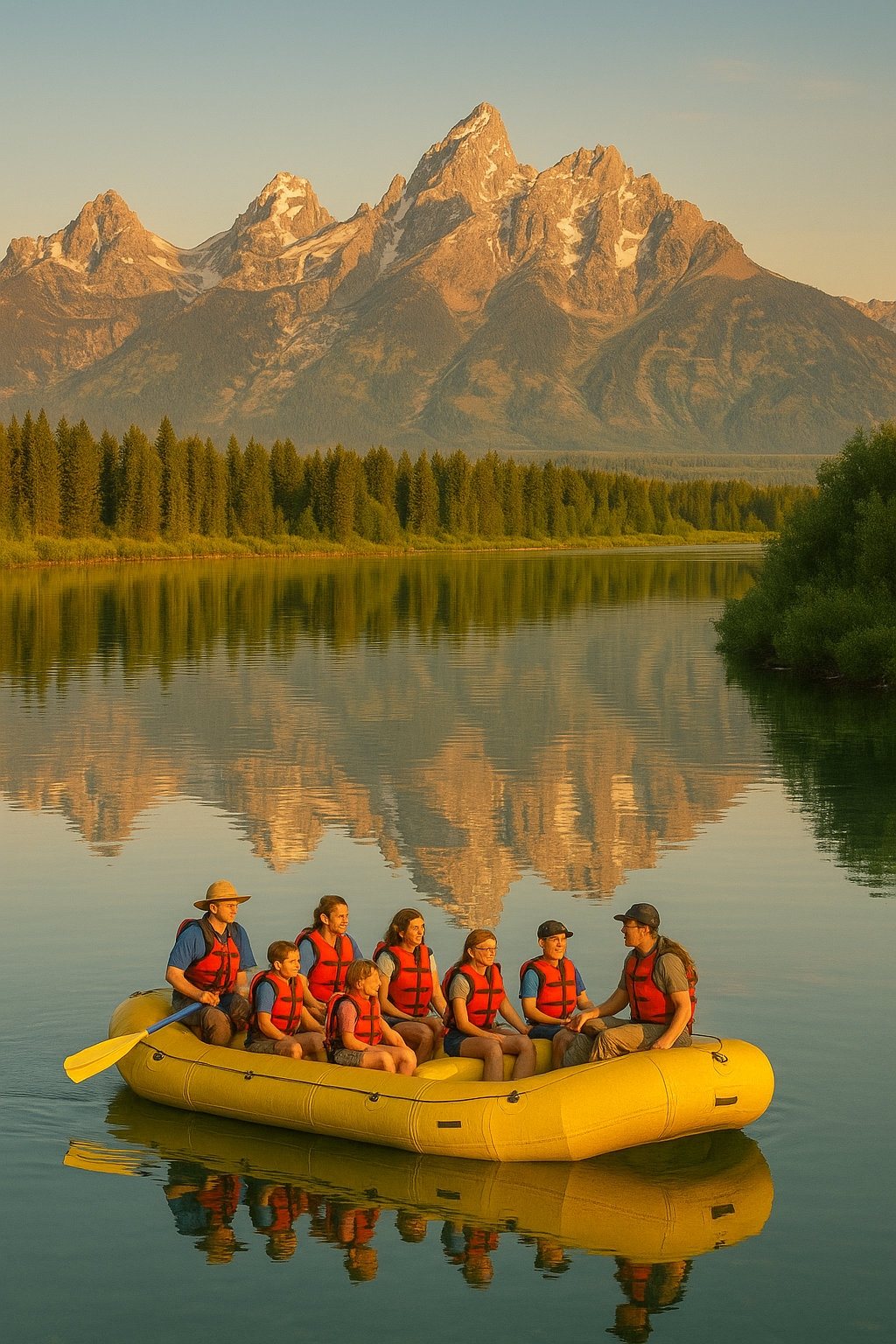
Choosing Your First Rafting Experience
If you're new to whitewater rafting or planning a family adventure, Jackson's Snake River offers some of the most forgiving and scenic introduction opportunities in the American West. The key is selecting sections that provide genuine river experiences while maintaining reasonable safety margins and spectacular scenery.
Snake River Scenic Float provides the perfect introduction to river rafting just minutes from downtown Jackson. Starting below Jackson Lake Dam and flowing south through Grand Teton National Park for approximately 8 miles, this section offers calm water ideal for all ages while showcasing some of America's most iconic mountain scenery.
The scenic float typically runs 10-13 miles depending on the specific route and take-out point, taking 2.5-3 hours on the water. This section provides opportunities to spot moose, elk, bald eagles, osprey, and occasionally bears along the riverbanks while your guide shares natural history and points out wildlife. The Teton Range provides a dramatic backdrop throughout the float, with peaks like the Grand Teton (13,775 feet) rising directly from the valley floor.
Here's a pro tip: book morning scenic floats (8:00-10:00 AM departures) for the best wildlife viewing and photography opportunities. Animals are most active in early morning, and the light on the Tetons is spectacular before midday. Afternoon floats experience more wind and less wildlife activity, though sunset floats offer their own special beauty.
Whitewater Introduction on the Canyon Section offers the next step for those wanting to experience rapids while remaining in beginner-friendly territory. The upper portions of the Snake River Canyon, particularly the first 8 miles, provide Class I-II rapids that introduce whitewater concepts without overwhelming new rafters.
Triangle X Float offers an intermediate option combining scenic beauty with gentle rapids, providing a bridge between the calm scenic float and more serious whitewater. This section, which can be combined with the scenic float for longer trips, introduces wave trains and simple rapids while maintaining the spectacular Teton scenery.
Understanding River Classifications and What They Mean
The International Scale of River Difficulty rates rapids from Class I (easy) to Class VI (extreme danger/unraftable). Understanding these classifications helps you choose appropriate sections based on your experience and comfort level.
Class I: Fast-moving water with small waves and few obstructions. Minimal risk; easy self-rescue. (Upper scenic float sections)
Class II: Straightforward rapids with wide, clear channels obvious without scouting. Some maneuvering required. (Lower scenic float, upper canyon)
Class III: Rapids with moderate, irregular waves that may be difficult to avoid. Complex maneuvers in fast current. Scouting advisable. (Snake River Canyon main section)
Class IV+: Intense, powerful rapids requiring precise boat handling. Scouting mandatory. (Lunch Counter, Big Kahuna in high water)
Jackson's commercially rafted sections range from Class I scenic floats to Class III+ whitewater in the canyon, with some rapids approaching Class IV during peak runoff. All commercial trips operate with professional guides trained in swift-water rescue and wilderness first aid.
Water Level Impact: The Snake River's character changes dramatically with water levels. Peak runoff (late May through early July) creates bigger, more powerful waves and faster current. Mid-summer (July-August) offers more moderate flows with clear water and warmer air temperatures. Late season (September) provides the smallest water levels with technical rock navigation replacing big waves.
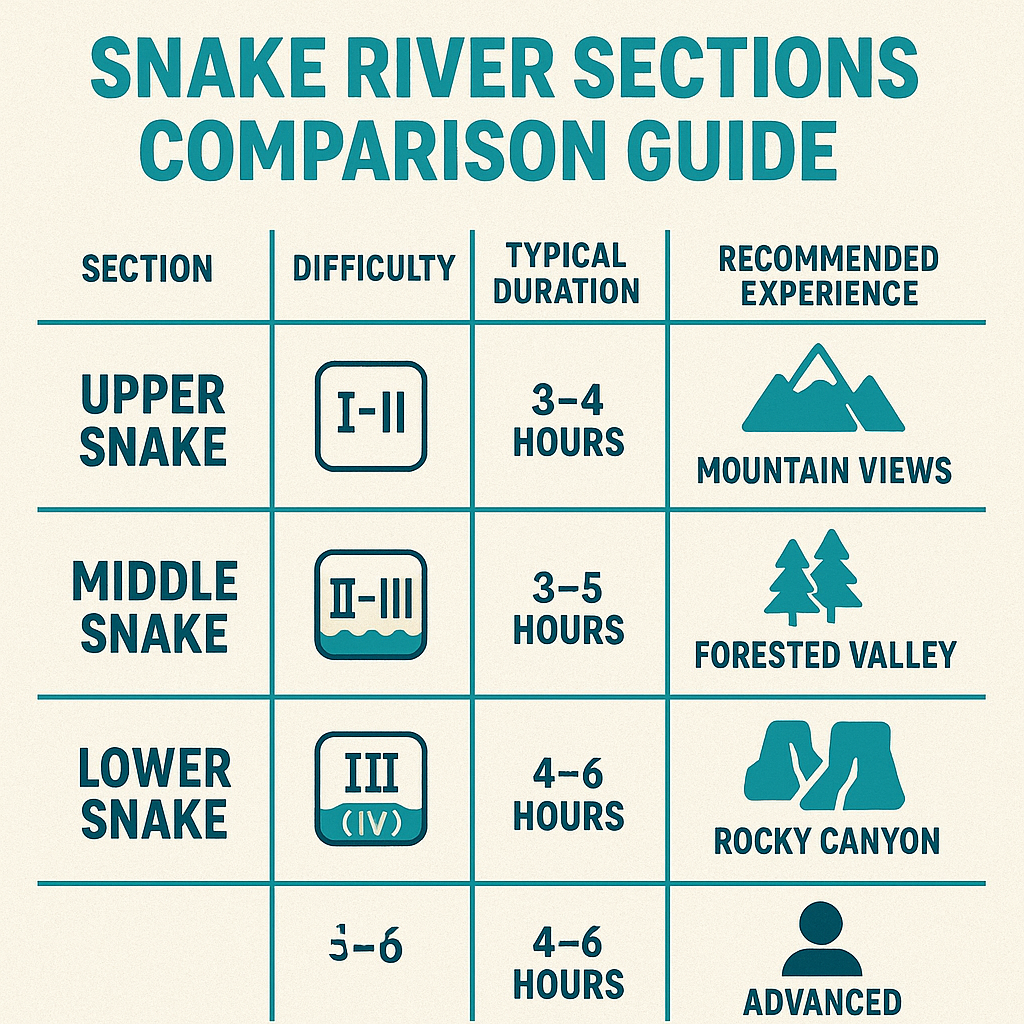
Essential First-Timer Information
Age and Physical Requirements: Most outfitters require rafters to be at least 6 years old for scenic floats and 8-12 years old for whitewater sections, depending on water levels and specific rapids being run. Physical fitness requirements remain minimal for commercial trips as guides handle most technical maneuvering, but participants should be comfortable in boats and able to hold on during bumpy water.
Swimming Ability: You don't need to be a strong swimmer for commercial rafting trips, but you should be comfortable in water and willing to get wet. All participants wear Coast Guard-approved life jackets, and guides are trained in swift-water rescue. However, fear of water or inability to handle brief submersion makes rafting stressful rather than enjoyable.
What to Expect: Whitewater rafting means you WILL get wet, even on scenic floats. The combination of paddle splashing, waves, and occasional spray means waterproof clothing and secure waterproof bags for valuables are essential. Water temperatures in the Snake River remain cold (typically 43-55°F depending on season and source), requiring wetsuits during early season and potentially throughout summer for cold-sensitive individuals.
WHITEWATER CANYON: The Classic Jackson Experience
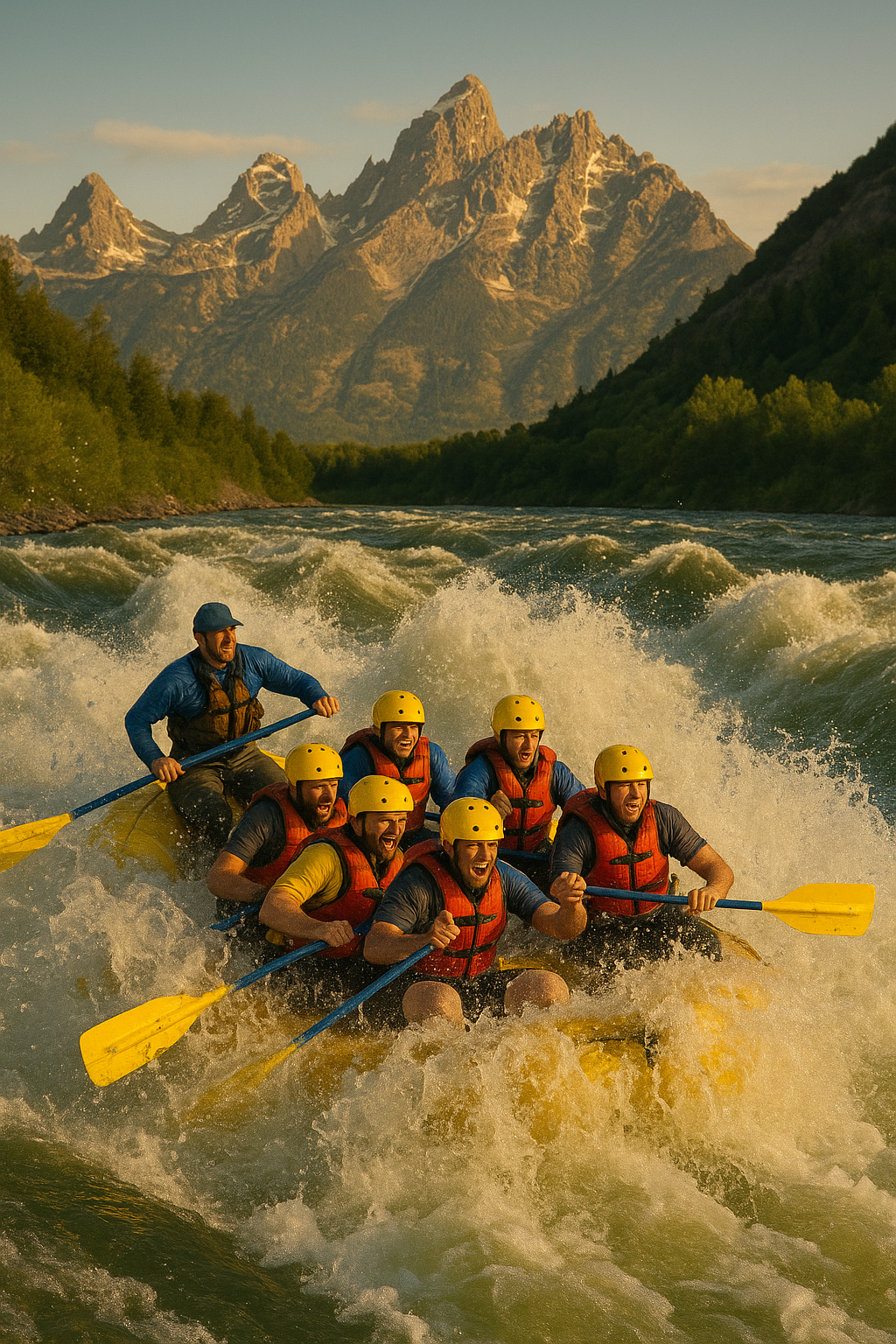
The Snake River Canyon Run
The Snake River Canyon section from Hoback Junction south to Sheep Gulch provides Jackson's signature whitewater experience. This 16-mile stretch drops through a scenic canyon with continuous Class II-III rapids, spectacular geology, and reliable excitement from June through September.
Major Rapids and What to Expect: The canyon contains over a dozen named rapids with characteristics that change based on water levels. During peak runoff (late May-early July), rapids grow larger and more powerful, with some approaching Class IV difficulty. Mid-summer provides classic Class III whitewater, while late season requires more technical maneuvering around exposed rocks.
Lunch Counter represents the canyon's most famous rapid, located about midway through the run. This long rapid features multiple waves, holes, and routes requiring strategic navigation. At high water, Lunch Counter can produce waves 5-6 feet tall with powerful hydraulics that flip inexperienced boats. Commercial rafts handle it well with experienced guides, but private boaters should scout carefully and understand their line before committing.
Rope Rapid follows shortly after Lunch Counter, creating a second challenging section. The name comes from historical boat lines used during log drives. Modern rafters navigate a technical entrance leading to large waves and a potential hole on river right that demands respect during high water.
Kahuna (Big Kahuna) provides another significant rapid in the upper canyon with a reputation for flipping boats during peak flows. The rapid features a large wave train ending in a substantial hole that can catch and hold rafts. Most commercial trips run this rapid on river left, avoiding the biggest features while still providing substantial excitement.
Canyon Logistics and Trip Planning
Standard Canyon Trips typically run 3-4 hours on the water covering the full 16-mile section from Hoback Junction to Sheep Gulch. Half-day trips leave morning (8:00-9:00 AM) or afternoon (1:00-2:00 PM), with morning trips generally experiencing slightly higher water levels due to overnight dam releases upstream.
Lunch Trips combine canyon rafting with riverside lunch stops, extending the experience to 4-5 hours total. These trips allow time to explore side canyons, swim in calmer sections (during warmer weather), and enjoy the canyon environment rather than just running rapids.
Water Level Considerations: The Snake River Canyon runs at dramatically different levels throughout the season, changing the character of the experience significantly. Early season high water (3,000-6,000+ cfs) creates powerful, pushy rapids with big waves and fast current. Mid-summer flows (2,000-3,000 cfs) provide classic whitewater with clear routes and manageable features. Late season (1,500-2,000 cfs) requires more technical navigation around rocks but offers warmer water and air temperatures.
Check current flows before booking. The USGS gauge at Hoback Junction (station 13011000) provides real-time data. Flows above 4,000 cfs create notably bigger whitewater, while flows below 2,000 cfs require more rock navigation and technical skill.
Safety Considerations for Canyon Rafting
Cold Water Reality: The Snake River remains dangerously cold throughout the rafting season, with temperatures rarely exceeding 55°F even in late summer. The combination of snowmelt from Yellowstone and glacial sources in the Tetons means hypothermia remains a year-round concern for anyone spending extended time in the water.
All commercial outfitters provide wetsuits, splash jackets, and appropriate thermal protection. Never raft the canyon without proper cold-water protection, even during hot summer days. Unexpected swims in 45°F water lead to rapid loss of coordination, strength, and decision-making ability even for strong swimmers.
Rapid Swimming and Self-Rescue: If you fall out of the raft, assume the "defensive swimming position" immediately: feet up and pointed downstream, floating on your back to protect against rocks. Never stand up in moving current above your knees—foot entrapment is a leading cause of whitewater deaths. Listen to your guide's instructions and grab the throw rope when it arrives rather than trying to swim to shore in strong current.
High Water Hazards: During peak runoff (typically late May through early July), the Snake River Canyon becomes significantly more dangerous with faster current, larger hydraulics, and more powerful rapids that can hold and recirculate swimmers. Commercial trips continue operating, but expect more intense conditions. If you're nervous about whitewater, avoid peak runoff periods and book mid-summer trips when flows moderate.
MULTI-DAY AND ADVANCED EXPEDITIONS
Extended Snake River Wilderness Trips
For experienced rafters or those wanting immersive wilderness experiences, multi-day Snake River expeditions combine whitewater with camping, fishing, and extensive wildlife viewing. These trips cover longer sections of river, including wilderness areas inaccessible by road.
Grand Teton to Snake River Canyon Expeditions combine the scenic float through the Tetons with overnight camping and continuation into the whitewater canyon. These 2-3 day trips provide comprehensive Snake River experiences with time to explore side canyons, fish for cutthroat trout, and experience the river environment beyond commercial day trips.
Yellowstone to Jackson Trips represent the ultimate Snake River expedition, covering 50+ miles from Yellowstone's South Entrance through Grand Teton National Park and into the whitewater canyon. These 3-5 day expeditions require permits, careful planning, and either outfitter booking or significant self-supported rafting experience.
Private Rafting and Permit Requirements
Grand Teton National Park Permits: All overnight river trips within Grand Teton National Park require backcountry permits obtained through the park's permit system. Campsites are designated and limited, requiring advance reservations (available starting January 1 for the upcoming season). Permits cost $45 for groups up to 6 people, with additional fees for larger groups.
Launch Regulations: Even day trips require launch permits for certain sections. Private boaters must register at park visitor centers before launching on sections within Grand Teton National Park. The Snake River Canyon section below Hoback Junction (outside park boundaries) requires no permits for day trips but demands appropriate skills and equipment.
Required Skills and Equipment: Private rafting on the Snake River Canyon requires Class III+ whitewater experience, appropriate equipment including self-bailing rafts or suitable kayaks/catarafts, proper safety gear (helmets, PFDs, throw bags, first aid), and understanding of cold-water protocols. This isn't a river for learning whitewater skills—numerous accidents occur each season involving inadequately prepared private boaters.
Technical Kayaking and Advanced Options
Snake River Kayaking: The Snake River Canyon attracts expert kayakers training for competitions and pushing their limits in cold, powerful water. The reliable flows, consistent rapids, and roadside access make this a premier kayaking destination for those with appropriate skills.
Several kayaking spots provide play waves and holes where boaters practice freestyle moves and surf features. Lunch Counter contains several play spots, while various other rapids provide challenging features. However, kayaking the Snake River Canyon requires solid Class III+ skills, appropriate cold-water gear (drysuit recommended), and understanding of swift-water self-rescue.
Rafting to Kayaking Progression: Many Jackson locals progress from commercial rafting to private trips to eventually kayaking the Snake River system. This progression typically takes years and should include formal instruction, practice on easier rivers, and gradual skill building rather than jumping directly from commercial trips to solo kayaking.
SEASONAL RAFTING: Timing Your Jackson Adventure
Spring Runoff Season (Late May - Early July)
Spring brings the Snake River's highest and most powerful flows as snowmelt from Yellowstone, the Tetons, and surrounding mountains converges in the valley. Peak runoff typically occurs mid-June to early July, with flows in the canyon reaching 4,000-8,000 cfs compared to mid-summer flows of 2,000-3,000 cfs.
High Water Characteristics: Spring runoff transforms the Snake River Canyon into a considerably more serious undertaking. Rapids double in size, hydraulics become more powerful, and the swift current leaves less time for corrections. Lunch Counter and other major rapids can produce standing waves 6+ feet tall with violent hydraulics capable of flipping rafts and holding swimmers.
Commercial outfitters continue operating through runoff, but expect more intense experiences. Many companies require higher minimum ages (12-14 vs. 8-10) during peak flows and may close certain trips if water exceeds safe operational levels. This is the time for experienced rafters seeking big water, not beginners wanting gentle introductions.
Cold Water and Weather: Spring water temperatures remain extremely cold (42-48°F) as rivers run with pure snowmelt. Air temperatures can vary from 40s to 70s°F, with afternoon thunderstorms common. Full wetsuits, splash jackets, and sometimes drysuits become necessary equipment. The combination of cold water and variable weather requires proper preparation—hypothermia risk is highest during spring season.
Wildlife Viewing Excellence: Spring offers spectacular wildlife viewing opportunities as animals emerge from winter and concentrate near rivers. Moose, elk, and deer graze valley bottoms, while bears (both black and grizzly) frequent riverbanks searching for winter-killed carcasses and early vegetation. Osprey and eagles nest along the river, providing constant aerial entertainment.
Summer Prime Season (July - August)
Summer provides the Snake River's most consistent and user-friendly rafting conditions. Flows moderate to 2,000-3,500 cfs in the canyon, air temperatures warm into the 70s-80s°F, and weather stabilizes with long sunny days perfect for water activities.
Moderate Water Advantages: Mid-summer flows create ideal conditions for learning and enjoying whitewater. Rapids remain exciting with waves 2-4 feet tall but lose the overwhelming power of spring runoff. Clear water allows you to see bottom features and rocks, while warmer temperatures make unexpected swims less dangerous (though still cold enough to require wetsuits).
The scenic float section shines during summer with calmer water, easier wildlife spotting, and comfortable temperatures for young children and older adults. This is peak family rafting season when most people visit Jackson and book river trips.
Booking and Crowds: Summer represents high season for Jackson tourism, meaning rafting trips book weeks or months in advance. Popular morning departure times (8:00-10:00 AM) fill first, especially for weekends. Book early (March-April for July-August trips) or remain flexible about dates and times. Midweek trips experience less crowding both on river and at put-ins/take-outs.
Weather Patterns: Summer weather typically provides sunny mornings with afternoon thunderstorms developing over the mountains. Most morning trips finish before weather arrives, while afternoon trips may encounter storms. Lightning poses serious risks in open rafts—outfitters will delay or cancel trips if dangerous weather develops. Bring rain gear regardless of morning forecasts.
Fall Opportunities (September)
September brings Jackson's most pleasant weather conditions with warm, stable days, cooler nights, and minimal precipitation. Fall colors develop in the cottonwoods along the river and aspens in the mountains, creating spectacular scenic beauty. However, water levels drop to season lows (1,500-2,000 cfs in the canyon), changing the river's character significantly.
Low Water Characteristics: September flows expose rocks and require more technical navigation. Rapids become less about big waves and more about threading precise routes between obstacles. This benefits experienced rafters who enjoy technical challenges but frustrates those expecting splashy wave trains and powerful rapids.
The scenic float remains excellent through September with outstanding wildlife viewing (elk rut begins), spectacular fall colors, and comfortable temperatures. Many consider September the premier month for scenic floats despite lower water levels.
Season Closure: Most commercial rafting operations close by late September as water temperatures drop, demand decreases, and flows become marginal for larger commercial rafts. Some companies offer trips through early October in warm weather years, but options become limited.
Winter Considerations (October - May)
The Snake River doesn't freeze in winter due to dam releases and flowing water, but winter rafting is almost non-existent. Water temperatures drop below 40°F, air temperatures frequently below freezing, and ice forms along shorelines. The extreme cold-water environment creates life-threatening risks for even brief exposure.
A few hardy kayakers paddle the river through winter using drysuits and extensive cold-water safety protocols, but commercial operations remain closed. Winter is the off-season in Jackson's rafting industry when guides work ski jobs and equipment undergoes maintenance.
CHOOSING OUTFITTERS AND SERVICES
Major Jackson Rafting Companies
Jackson's rafting industry includes 20+ licensed outfitters ranging from large operations running dozens of trips daily to boutique companies offering specialized experiences. Choosing the right outfitter depends on group size, experience level, desired trip type, and personal preferences regarding group dynamics and guide style.
Mad River Boat Trips operates as one of Jackson's oldest and largest rafting companies, established in 1978. They run the full range of trips from scenic floats through Grand Teton National Park to whitewater canyon expeditions, with capacity for large groups and consistent operations throughout the season.
Mad River emphasizes safety and environmental education, with guides trained in natural history and Leave No Trace principles. Their larger operation provides reliability and capacity but means bigger groups and less intimacy than smaller boutique operators.
Dave Hansen Whitewater specializes in whitewater-focused trips with smaller group sizes and expert guides. Founded by former Olympic kayaking coach Dave Hansen, the company attracts serious whitewater enthusiasts and those wanting challenging experiences rather than gentle introductions.
Dave Hansen trips maintain smaller raft sizes (6-8 people vs. 12-14 on some competitors' boats) and employ predominantly expert-level guides with extensive whitewater backgrounds. Expect more technical river knowledge and less crowd-pleasing entertainment than mass-market operators.
Barker-Ewing Scenic Float Trips focuses exclusively on the scenic float through Grand Teton National Park, offering no whitewater trips. Their specialization allows deep expertise in wildlife viewing, natural history, and photographic opportunities while maintaining strong safety records and environmental stewardship.
Barker-Ewing's smaller rafts (10-12 passengers) provide better sightlines and more intimate experiences than larger boats. Their guides receive specific training in wildlife behavior and identification, making this an excellent choice for nature-focused families and photographers.
Triangle X Float Trips operates from the historic Triangle X Ranch within Grand Teton National Park, providing both scenic floats and the intermediate Triangle X section combining scenery with mild rapids. Their position within the park creates convenient access and authentic Western atmosphere.
Evaluation Criteria for Outfitter Selection
Safety Records and Certifications: All licensed outfitters meet Forest Service and National Park Service safety requirements, but some exceed minimums. Look for companies emphasizing guide training, swift-water rescue certification, wilderness first aid/responder qualifications, and comprehensive safety briefings.
Ask about guide-to-guest ratios, safety kayaker protocols (some companies provide safety kayakers during high water), and incident response procedures. Reputable companies openly discuss safety without evasion or dismissiveness.
Guide Quality and Experience: Guide experience varies dramatically between companies and even within companies' guide rosters. Established companies like Mad River and Dave Hansen maintain predominantly experienced guides with multiple seasons on the Snake River. Smaller or newer operations may rely more heavily on first-year guides still learning the river.
Guide quality matters enormously for trip enjoyment and safety. Experienced guides read water better, position boats more skillfully, provide richer natural history interpretation, and handle emergencies more effectively. Don't hesitate to ask about guide experience levels and request specific guides if you're booking repeat trips.
Group Size and Boat Types: Raft capacity ranges from 4-6 person boats to 14+ passenger rafts. Smaller boats provide more intimate experiences, better guide interaction, and often more exciting rides (lighter boats bounce more). Larger boats offer stability, accommodation for nervous rafters, and efficient handling of large family groups.
Some companies offer paddle rafts where all passengers paddle together under guide instruction, while others use oar rigs where the guide rows and passengers ride. Paddle rafts create more active participation but require coordination and moderate physical ability. Oar boats allow passengers to relax and enjoy scenery but provide less engagement.
Environmental Ethics: Jackson's rafting industry operates in sensitive environments including Grand Teton National Park and significant wildlife habitat. Choose companies demonstrating environmental commitment through Leave No Trace practices, wildlife respect protocols, and conservation support.
Watch for companies participating in river cleanup efforts, supporting conservation organizations, and providing environmental education beyond required minimums. These indicators suggest genuine stewardship rather than purely commercial operations.
Trip Types and Options
Standard Half-Day Trips represent the most common rafting format—3-4 hours on water covering either the scenic float (8-10 miles) or whitewater canyon (16 miles). These trips require minimal time commitment while providing genuine river experiences suitable for most schedules.
Full-Day Expeditions combine multiple river sections or add extended lunch stops, exploring side canyons and swimming holes. These 6-8 hour trips suit those wanting deeper immersion and less time pressure. Full-day trips typically include riverside lunch with better-quality food than quick snack stops on half-day trips.
Multi-Day Camping Expeditions provide the ultimate Snake River experience with overnight camping, comprehensive meals, and extensive river mileage. These trips range from 2-day weekenders to 5-day wilderness expeditions covering the river from Yellowstone to Hoback Junction.
GEAR AND PREPARATION
What to Wear and Bring
Clothing Strategy: The phrase "dress for immersion" applies to all whitewater rafting. Even on scenic floats, you'll get splashed. On canyon trips, you'll get soaked. Plan your outfit assuming you'll be wet, cold, and sitting in a boat for 3-4 hours.
Early Season (May-June):
Synthetic or wool base layers (never cotton)
Wetsuit provided by outfitter
Splash jacket provided by outfitter
Wool socks or neoprene booties
Secure hat (baseball cap with strap)
Sunglasses with retainer strap
Sunscreen (reef-safe for environmental protection)
Mid-Summer (July-August):
Quick-dry shorts and synthetic shirt
Wetsuit (outfitters still provide, conditions warrant)
Light fleece or insulating layer (starts cool, warms up)
River sandals with heel straps (Chacos, Tevas) or water shoes
Hat and sunglasses with retainers
Sunscreen (critical at 6,000+ feet elevation)
Late Season (September):
Return to early season layering approach
Full wetsuit recommended despite warmer air
Extra insulating layers for after rafting
Warm hat and gloves for morning trips
What NOT to Wear:
Cotton clothing ("cotton kills" in cold-water environments)
Loose-fitting sandals or flip-flops
Jewelry or watches that could catch on equipment
Expensive sunglasses without retainers
Regular tennis shoes (they'll get soaked and stay wet)
Personal Items and Valuables
Waterproof Protection: Outfitters provide small dry bags for valuables, but these are limited in size (typically 10-20 liters). Bring only essential items:
Car keys
Phone (in waterproof case—remember you may have no reception on river)
Wallet with ID and cash for tipping
Prescription medications if needed during trip
Extra contact lenses and glasses
Leave everything else locked in your vehicle at the meeting point. Hotels, rental cars, and other non-essentials stay behind—there's no secure storage on the river.
Photography Considerations: Getting good photos on rafting trips requires waterproof equipment or protective cases. Options include:
Waterproof phone cases (test them before trip in sink or pool)
GoPro or action cameras with secure mounting
Waterproof point-and-shoot cameras
Professional waterproof camera bags for DSLR/mirrorless
Many rafters choose to leave cameras behind and purchase professional photos at major rapids. This eliminates equipment risk while ensuring at least some action shots. Your choice depends on how important photography is versus enjoying the experience without equipment concerns.
Physical Preparation and Fitness
Fitness Requirements: Commercial rafting requires minimal fitness. You need ability to:
Walk short distances on uneven terrain at put-ins and take-outs
Climb in and out of rafts from shore or docks
Sit in boat for extended periods
Hold on during rapids
Follow basic instructions
However, reasonable physical condition improves safety margins. If you fall out, you need enough strength to grab throw ropes and assist in your own rescue. Completely sedentary individuals with mobility issues may struggle with entry/exit and emergency situations.
Health Considerations: Notify outfitters of relevant health conditions:
Heart conditions or high blood pressure
Back or neck injuries that limit mobility
Pregnancy (many companies prohibit pregnant women from whitewater trips)
Recent surgeries or healing injuries
Medications that affect balance or coordination
Age restrictions vary by company and water levels, but typical minimums are:
Scenic float: 4-6 years old
Whitewater canyon: 8-12 years old (depends on current flows)
Multi-day trips: Usually 12+ years old
SAFETY AND RISK MANAGEMENT
Understanding Whitewater Risks
Objective Hazards: The Snake River presents real risks that responsible rafters acknowledge and manage rather than ignore:
Cold Water Immersion: The river's 43-55°F water temperature creates rapid incapacitation. Within 3-5 minutes of immersion, you lose fine motor skills and strength. Within 10-15 minutes, swimming ability diminishes significantly. Cold-water shock during initial immersion can cause gasping and aspiration even in strong swimmers.
Commercial trips minimize this risk through proper equipment (wetsuits), trained guides, and swift rescue protocols. But the cold water remains an objective hazard requiring respect and preparation.
Powerful Hydraulics: Holes and hydraulics form where water flows over rocks or drops, creating recirculating currents that can trap boats and swimmers. During high water, major rapids like Lunch Counter contain hydraulics powerful enough to hold and recirculate rafts and swimmers.
Guide expertise and proper boat positioning prevent most hydraulic problems, but the features exist and occasionally catch boats. Understanding how to escape hydraulics (swim deep, let the current push you out the bottom) provides important safety knowledge even on commercial trips.
Foot Entrapment: Standing in current above knee depth risks foot entrapment where your foot wedges between rocks while current pushes your body downstream. This position is extremely difficult to escape and causes numerous drowning deaths in rivers nationwide.
NEVER stand up in current during rapids or swift water. If you fall out, immediately assume defensive swimming position (on back, feet up and downstream) and NEVER try to stand until you reach completely calm water with depth less than knee-deep.
Medical and Emergency Preparedness
Guide Training Standards: All licensed Jackson outfitters require guides to maintain:
Current Wilderness First Responder (WFR) or Wilderness First Aid (WFA) certifications
CPR and AED training
Swift-water rescue certification
Annual training updates and skills maintenance
This training ensures guides can handle medical emergencies ranging from minor cuts and sprains to serious injuries requiring evacuation. However, understanding that you're in wilderness environments hours from hospitals provides important context about rescue timing.
Evacuation Procedures: Serious medical emergencies on the river require evacuation by:
Helicopter extraction (weather permitting)
Ground ambulance to nearest road access (may require rafting to take-out first)
Guide-initiated rescue and stabilization until professional medical help arrives
Helicopter evacuation from the Snake River Canyon typically occurs within 30-60 minutes of emergency call, weather permitting. But storms, darkness, or mechanical issues can delay this considerably. The remoteness is part of the experience—but it means self-sufficiency and guide competence matter enormously.
Personal Medical Preparation:
Inform guides of relevant medical conditions during check-in
Bring and use prescribed medications (in waterproof containers)
Understand that altitude (6,200+ feet) affects some people
Know your own limitations and communicate concerns
Don't let pride or peer pressure override safety judgment
Weather-Related Hazards
Lightning Risk: Summer afternoon thunderstorms over the Tetons frequently produce dangerous lightning. Being on the water in an open raft during lightning creates serious risk—water conducts electricity, rafts provide minimal protection, and no safe shelter exists on the river.
Reputable outfitters monitor weather carefully and delay trips or pull off the river if lightning threatens. Don't pressure guides to continue during electrical storms—they're making safety decisions based on training and experience. The commercial rafting industry has an excellent safety record partially because outfitters respect weather and don't take unnecessary risks.
Flash Flooding: Heavy rainfall in the mountains can cause rapid water level rises even when the valley experiences no rain. The Snake River's dam-controlled flows minimize flash flood risk compared to free-flowing rivers, but tributaries entering the canyon can rise quickly during intense storms. Guides monitor water color (muddy inflows indicate upstream rain) and adjust plans if conditions warrant.
High Water Conditions: During peak runoff, the Snake River's power increases exponentially. Water moving at 6 mph (typical high flow) exerts four times the force of water at 3 mph (moderate flow). This affects everything—swimming difficulty, boat control, hydraulic power, and consequence of mistakes.
Commercial outfitters adjust operations based on water levels, potentially closing certain trips, raising age minimums, or adding safety kayakers. These adjustments reflect genuine risk increases, not excessive caution. Trust outfitter judgment about whether conditions match your group's abilities.
Wildlife Safety Considerations
Bear Awareness: Both black bears and grizzly bears inhabit the Snake River corridor, particularly in Grand Teton National Park sections. While encounters from rafts are rare (bears typically avoid river noise), shoreline stops and camping trips enter bear territory requiring proper protocols.
Multi-day trips require bear-resistant food storage, proper camp setup (sleeping area 100+ yards from cooking area), and understanding of bear encounter responses. Day trips minimize bear risk, but awareness and proper food handling prevent attracting bears to high-use areas.
Moose Encounters: Moose are unpredictable and potentially dangerous, particularly cows with calves during summer. While rafts provide safe viewing platforms, shoreline encounters during breaks require caution. Give moose wide berth (minimum 25 yards), never position yourself between cow and calf, and back away slowly if a moose shows aggression signs (ears back, raised hackles, stomping).
Snake and Insect Considerations: Rattlesnakes inhabit rocky areas along the Snake River Canyon, though encounters are uncommon. Watch where you place hands and feet during shoreline breaks. Bees, wasps, and hornets nest along riverbanks and can be aggressive if disturbed. Those with severe allergies should carry EpiPens in waterproof containers.
Summary: Your Snake River Adventure Awaits
Jackson, Wyoming, and the Snake River system provide whitewater rafting experiences combining world-class scenery with diverse water conditions suitable for all experience levels. From peaceful scenic floats perfect for young families to challenging Class III rapids that test experienced rafters, the Snake River delivers authentic Western river adventures in the shadow of the iconic Teton Range.
The key to excellent Jackson rafting experiences lies in honest self-assessment of abilities and interests, choosing appropriate trips and reputable outfitters, respecting the river's cold-water environment, and approaching the adventure with reasonable expectations. This isn't wilderness expedition rafting requiring extensive self-sufficiency—professional guides and established infrastructure create accessible experiences while maintaining authentic character and genuine excitement.
Start planning your Snake River adventure by:
Determining your preferred experience type (scenic float vs. whitewater)
Selecting optimal timing (peak runoff for big water, mid-summer for moderate flows and warm weather, fall for colors and solitude)
Researching and booking reputable outfitters (4-8 weeks ahead for peak season)
Preparing appropriate clothing and gear (dress for immersion in cold water)
Combining rafting with other Jackson activities (hiking, wildlife viewing, cultural experiences)
The Snake River flowing through the Tetons creates one of America's most spectacular rafting destinations. Whether you're seeking family-friendly introduction to river running, exciting whitewater that gets your adrenaline pumping, or multi-day wilderness expeditions combining rafting with camping under Teton stars, Jackson delivers experiences that satisfy diverse interests while showcasing why Outside Magazine named this one of the "Best River Towns in America."
Get out on the Snake River and discover why generations of rafters return year after year to these remarkable waters flowing through the heart of the Greater Yellowstone Ecosystem. The river awaits—cold, clear, and spectacular.
